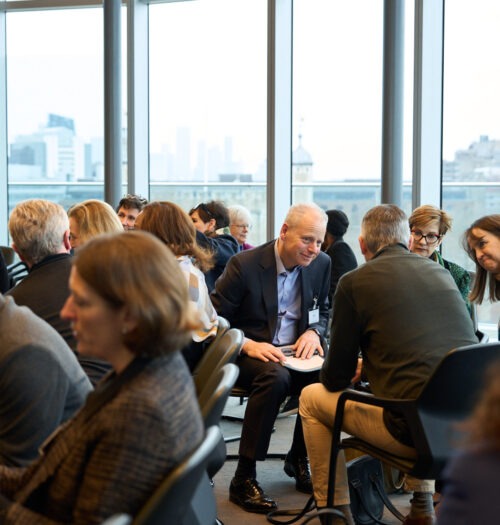
Oliver Wyman Masterclass #1: Transition Planning and your role
Download the full summary
You can share the event summary with your fellow board members and colleagues by inviting them to join Chapter Zero, sharing the webpage link with them, and downloading the designed resource here.
Oliver Wyman Masterclass #1: Transition planning and your role - Event summaryTransition Planning: What it is and why it matters
- The IFRS S2 outlines a climate transition plan (CTP) as an aspect
of an entity’s overall strategy that lays out its targets, actions
or resources for its transition towards a lower-carbon economy,
including actions such as reducing its GHG emissions. - Transition plans are important as an external communication tool
and an internal transformation mechanism. - The UK TPT published a Disclosure Framework in October 2023
that outlines 19 sub-elements as a guide structure for a CTP with
three overarching principles: Ambition, Action, Accountability. - This is a rapidly evolving space with evolving government and
regulatory requirements and announcements expected in H1 2025. - Transition planning is not a “once and done” activity. A transition
plan should be flexible, dynamic and will need to evolve and be
regularly reviewed and updated.
Transition planning basics and best practices
We explored three deep dives on transition planning: 1. Ambition level and positioning, 2. What moves the dial in a transition plan and 3. Key stakeholders.
Deep Dive 1. Ambition level and positioning
We see a wide range of ambition levels within CTPs, ranging from minimalist compliance
focused reports to trendsetting plans which are integrated into overall strategy and focus on
value creation and risk management. Taking a strategic trendsetting approach will strengthen, challenge and enhance an organisation’s business strategy itself, unlocking
multiple benefits including value generation and resilience. To build alignment and understanding of ambition amongst the Board, NEDs should expect complete and robust information and facilitate open conversations about trade-offs, embracing challenge and debate and working together to find resolutions. There are several challenges and barriers to
setting high ambition levels such as geopolitical uncertainties, regulatory considerations, access to capital, stakeholder expectations, and technological advancement.
Whilst there are known risks to moving quickly, these can be mitigated through identifying no regrets moves and setting realistic timelines — such as considering the timeline for phasing out of fossil fuels. It is important to take a global perspective that includes emerging economies and a just transition, as well as considering adaptation & mitigation. Transition planning is a strategic endeavour to unlock value, and companies are encouraged to start early to signal intent to the various stakeholder groups. However, overly ambitious
public commitments should be avoided without proper understanding to avoid greenwashing.
Deep Dive 2. What moves the dial in a transition plan
There are 19 sub-elements of the TPT Disclosure Framework, but we see several areas that can most materially drive an organisation towards meeting its goals:
- Strategic Ambition: Align on ambition and put in place resources for success.
- Assumptions and external factors: Ensure clarity in assumptions and external dependencies.
- Financial Planning: Ringfence investment and enable effective capital allocation for the transition.
- Engage with the value chain: Actively and systematically engage across the value chain.
- Metrics and Targets: Set credible and realistic metrics and targets and leverage carbon pricing.
- Incentives and remuneration: Understand how senior management structure incentives for transition planning and climate initiatives.
Deep Dive 3. Key stakeholders
The landscape of stakeholders to consider when transition planning is interconnected,
complex and dynamic, requiring careful navigation and understanding of various
interests and influences. From employees to customers to governments and more, we should start to consider the main stakeholder groups, however, we can never be truly exhaustive and there may be large variations by company and location. Stakeholders that may often be overlooked include wider society, communities, the media, and academia as well as competitors and secondary stakeholders (e.g. those that fund and insure our partners). Future generations should also be considered given their importance as future employees, customers, investors, and more.
Top priorities for each stakeholder group vary, and even within stakeholder groups, priorities may not be aligned. Inevitably, there will be trade-offs and challenges faced when trying to balance those priorities which need to be articulated and discussed to ensure they are made consciously. When considering differing priorities and impact, we should keep in mind the desire for a just transition and use a double materiality lens where possible (taking into account both the impact of the transition on stakeholders and the impact of stakeholders on the transition). Balancing immediate needs with long-term goals also poses challenges due to uncertainty and timelines. In the face of these challenges, we must ask the
right questions, push for a plan that maintains flexibility and is dynamic but still commits to
action in a tangible and significant way.
We need to understand why we are putting together the transition plan and what it is for – what risks are we managing and what are the commercial benefits for our organisation?- NED Attendee
Further resources and learnings for non-executive directors
Key takeaways surfaced through discussion amongst peers in the session:
| Education of the Board is critical to ensure efficacy and robust challenge. | It is essential for Boards to be educated on climate and transition planning, and in particular, on what it means for their own organisations. Without this understanding, technicalities can act as a barrier to efficacy and progress. As NEDs, we should push for this education and be open to an environment of constant learning and debate. |
| It is important to know what you don’t know. | This is a rapidly evolving space with lots of uncertainty – to navigate this we must remain agile and curious. It is just as important to be aware of what you don’t know as well what you do. |
| Sustainability should be embedded in and driving corporate strategy — not a bolt on. |
Sustainability should be driving our corporate value, providing commercial value and ROI – it should not be a siloed / separate plan. |
| Intent of plans is key (not just the reporting of them) |
Reporting can be overwhelming, but it is the intent of a transition plan that is key. Reporting should not be seen just as a compliance exercise but as an opportunity to tell the narrative of your plan. |
| Take the first step – even if not perfect |
We are in the foothills of change. Everyone is on the learning journey. We will not be able to achieve everything on day one. There will be many challenges, there will always be trade-offs and we must be pragmatic. However, this should not stop us from taking the first step. |
| As NEDs, we should champion CSOs and build relationships throughout our organisations |
We should champion our CSOs, helping them to push the agenda at the Board level, supporting them in difficult conversations and encouraging a healthy atmosphere for debate. Building relationships throughout our organisation and bringing in diverse and broad perspectives will ensure a robust plan with greater ownership. |
| As NEDs, we should remain patient and encourage debate |
Driving alignment is critical. As a NED, we play a critical role in this and must be patient and consistent. We should seek to ask challenging questions, drive alignment and encourage debate. |
| There is no one size fits all, and we cannot do this alone |
We can use the TPT Disclosure Framework (and sector guidance) to guide our journey, but a transition plan must be firmly in the context of the organisation. The challenges and opportunities are vastly differently by company and region. Hence, we must adapt differently whilst still working together towards the common goal. |



